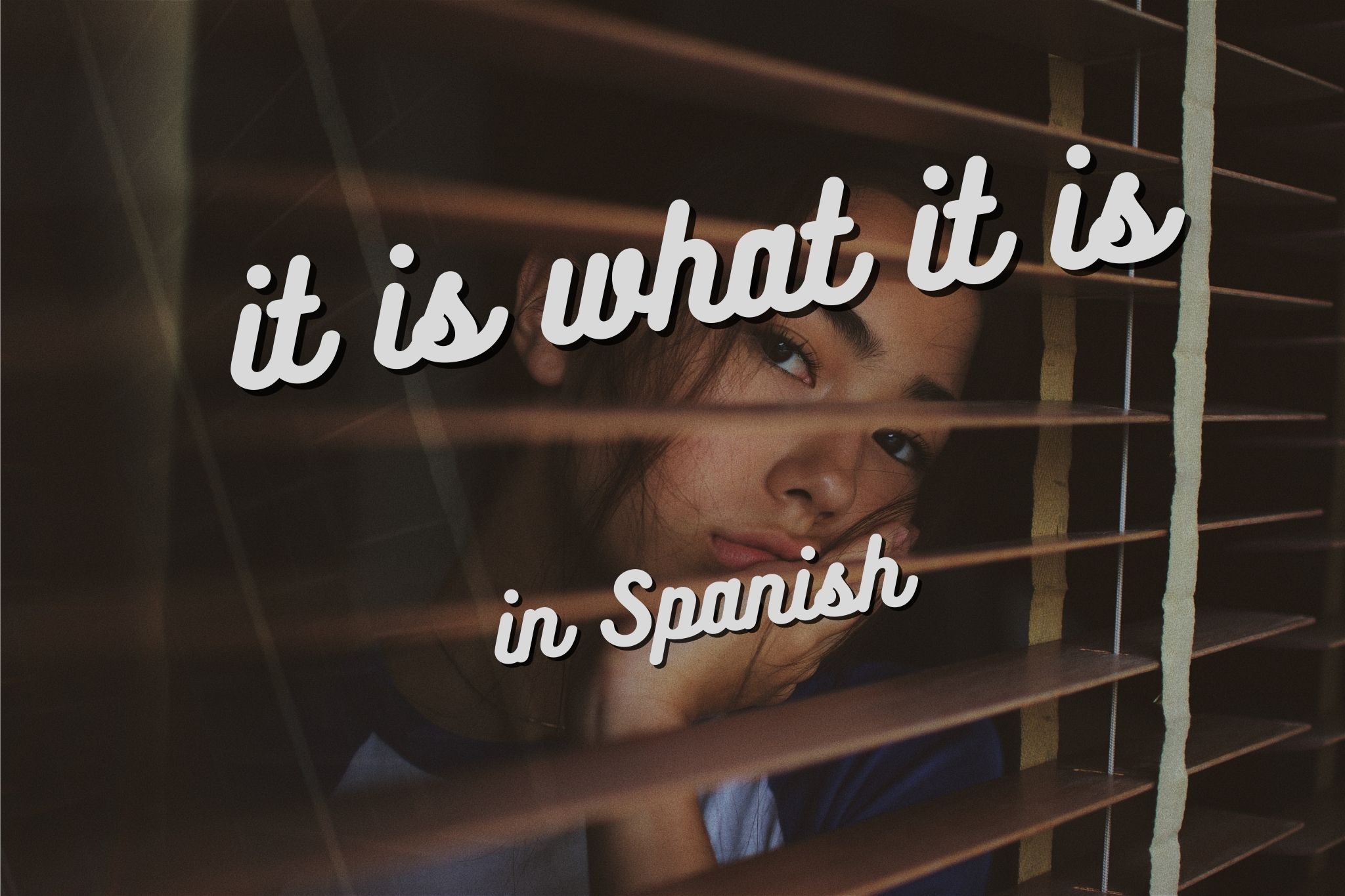“It is what it is” in Spanish: Essential idiomatic expressions

Get our free email course, Shortcut to Conversational.
Have conversations faster, understand people when they speak fast, and other tested tips to learn faster.
More infoWhen learning a language, in addition to studying vocabulary, grammar, and verb conjugations, you also need to learn idiomatic expressions. Learning a few options for saying it is what it is in Spanish is an easy way to spice up your conversation and really sound like a native speaker!
In this post we’ll cover some of the essential Spanish idiomatic expressions that people use to express acceptance of situations that could be better. These phrases are used quite frequently in everyday situations, so by learning a few of them you’ll quickly find good situations where they can be used.
We’ll begin with the literal version of it is what it is in Spanish: es lo que es. From there we’ll move onto other alternatives like es lo que hay, ¡qué remedio!, and es así, as well as couple of others that people normally use in Latin America. We’ll provide you with a proper explanation of each phrase along with plenty of examples, all in a crystal clear context for you to understand their usage. So without further ado, let’s get started!
It is what it is in Spanish
In English, you use the phrase it is what it is when faced with a frustrating or challenging situation that a person believes cannot be changed and just needs to be accepted. In Spanish, we also have some expressions that convey this same meaning.
We’ll start by introducing the most literal equivalent in Spanish: es lo que es. Then we’ll cover a few more idiomatic expressions with similar meanings.
Es lo que es
Es lo que es is the direct translation of it is what it is. Es lo que es expresses the same sense of frustration and acceptance of something that can’t be changed as it is what it is in English.
- Our house is a bit small, but it is what it is. – Nuestra casa es un poco pequeña, pero es lo que es.
- We went on vacation to a neighboring town. It is what it is. – Nos fuimos de vacaciones a un pueblo vecino. Es lo que es.
Es lo que hay
One of the most natural ways to say it is what it is in Spanish is es lo que hay. The main difference in usage over our previous expression is that it is more common in conversation. As you may have noticed, the only difference in construction is that es lo que hay uses hay in place of the verb ser.
If you are in an uncomfortable situation that can’t be changed, es lo que hay is a good option.
- This salary is insulting. / It is what it is, either you take it or leave it. – Este salario es insultante. / Es lo que hay, tómalo o déjalo.
- None of the students managed to get more than a C on the test. It is what it is. – Ningún estudiante logró obtener más de una C en el examen. Es lo que hay.
¡Qué remedio!
¡Qué remedio! is another way of stating that you have no choice or option and that destiny cannot be altered in any way. This emphatic expression is always used between exclamation marks.
Though the literal translation of “qué remedio” is “what remedy!,” when used as an idiomatic expression this phrase should really be considered on its own to express frustration and resignation. Aside from it is what it is, another possible translation in English could be what other choice do we have? The best translation really depends on the context.
- I don’t have a degree, so I have to work as a waiter in a restaurant for 10 hours a day. I have no other choice. – No tengo título de grado, entonces tengo que trabajar 10 horas por día de mesero en un restaurante. ¡Qué remedio!
- If we want to buy the house, we’ll have to ask the bank for a loan. What else can we do? – Si queremos comprar la casa, tendremos que pedir un préstamo al banco. ¡Qué remedio!
¿Qué le vamos a hacer?
This rhetorical question is used to express resignation when there’s nothing left to do. ¿Qué le vamos a hacer? can also be translated into English as what can we do about it? or so be it.
- She’s determined to live abroad away from her family. What can we do about it? – Ella está decidida a vivir en el extranjero lejos de su familia, ¿qué le vamos a hacer?
- Our mom wants to spend Christmas alone. So be it. – Nuestra mamá quiere pasar la Navidad sola, ¿qué le vamos a hacer?
Es así
Es así is a shorter option for it is what it is, whose best equivalent is that’s just the way it is. Sometimes when we have a problem, we think about it, and then we conclude that things are the way they are and there’s nothing we can do about it. The literal translation of es así is it is so.
- I missed the bus. I’m going to be late for work. It is what it is. – Perdí el bus. Voy a llegar tarde al trabajo. Es así.
- Teenagers don’t want to spend their weekends with their parents. That’s just the way it is. – Los adolescentes no quieren estar con sus padres los fines de semana. Es así.
Las cosas son así
Las cosas son así is the plural version of es así that we just saw. That’s the way things are is the literal translation, and it’s used similarly to express a reluctant acceptance of a situation that’s not ideal. Although the wording is very different, las cosas son así is a very suitable equivalent for it is what it is in Spanish.
- Global warming is the result of deficient public policies. That’s the way things are! – El calentamiento global es el resultado de políticas públicas deficientes. ¡Las cosas son así!
- The rich get richer and the poor get poorer, my son. That’s the way things are. – Los ricos se vuelven más ricos y los pobres más pobres, hijo mío. Las cosas son así.
No queda otra, No hay otra
The complete sentence of this phrases would be No queda otra opción. However, native Spanish speakers use the shorter version no queda otra, or even its far shorter version no hay otra. Both are equivalent, meaning there’s no other option.
These are useful expressions when we want to say that we have no choice, and that a situation is unavoidable.
- We have to pay our taxes. It is what it is. – Tenemos que pagar los impuestos, no hay otra.
- In Argentina, people have to vote for the president every four years. It is what it is. – En Argentina, el pueblo tiene que votar presidente cada cuatro años. No queda otra.
Conclusion
In this post, we’ve covered many phrases that people in Latin America use to express resignation and acceptance when faced with a mediocre situation that can’t be changed.
To conclude, let’s just summarize the different options we’ve learned for saying it is what it is in Spanish:
- Es lo que es
- Es lo que hay
- ¡Qué remedio!
- ¿Qué le vamos a hacer?
- Es así
- Las cosas son así
- No hay otra
- No queda otra
That’s all for today. We’re sure soon you’ll have the chance to either hear or use these common Spanish phrases you’ve learned, expressing acceptance of whatever situation you find yourself in!
We hope you’ve enjoyed this post. Otherwise, ¡Es lo que hay!



